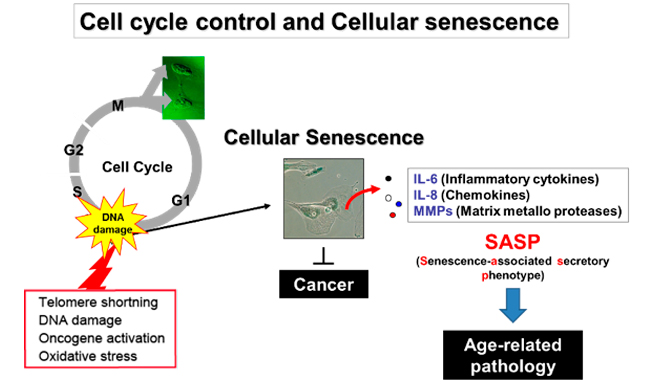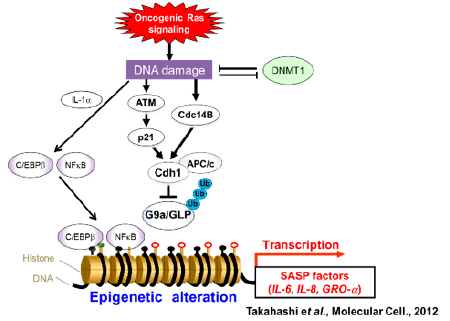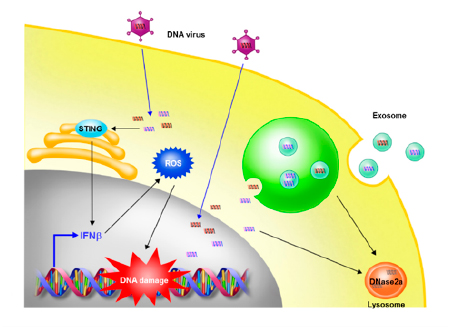Research

出典:細胞工学2015年
Cellular senescence is the state of irreversible cell cycle arrest provoked by a variety of potentially oncogenic stimuli, such as telomere shortening, DNA damage or activation of certain oncogenes (Takahashi et al., Nature Cell Biology, 2006: Imai et al., Cell Reports, 2014). We have demonstrated that cellular senescence appears to be acting as a barrier to cancer, preventing damaged cells from undergoing aberrant proliferation, through in vivo imaging analysis using p16 INK4a-imaging mice (Yamakoshi & Takahashi et al., J Cell Biology, 2009) or genetic analysis of p16 INK4a /p21WAF1/CIP1 knockout mice (Takeuchi et al., Cancer Research, 2011).

出典:細胞工学2012年
On the other hand, it has proven that senescent cells are accumulated during aging process throughout living body and secrete many inflammatory proteins into the surrounding extracellular fluid. This phenomenon is called senescence-associated secretory phenotype (SASP), suggesting that SASP factors promote some age-associated diseases such as chronic inflammation and cancer. Then, we try to understand the molecular mechanisms regulating SASP in senescent cells. As a result, we have reported that irreparable DNA damage provokes degradation of G9a and GLP epigenetic silencers through APC/CCdh1 ligase, thereby causing a decrease in Histone 3 Lysine 9, H3K9 di-methylation levels around the SASP factor gene promoter regions, such as IL6 or IL8 (Takahashi et al., Molecular Cell, 2012).

出典:
In addition to secretory proteins, senescent cells also increase the secretion of a class of extracellular vesicles called “exosomes”. Exosomes are endosomal membrane vesicles with diameters of approximately 40 to 150 nm. Additionally, it has been reported that exosomes play important roles in intercellular communication between cells. However, we have recently revealed that exosome secretion plays a crucial role in maintaining cellular homeostasis in exosome-secreting cells. Surprisingly, exosomes contain various lengths of chromosomal DNA fragments. Therefore the inhibition of exosome secretion results in the accumulation of nuclear DNA in the cytoplasm, thereby causing the activation of cytoplasmic DNA sensing machinery. We have discovered a new role of exosome secretion which maintains cellular homeostasis by removing harmful cytoplasmic DNA from cells (Takahashi et al., Nature Communications, in press). Finally, we try to understand the molecular mechanism of aging through the research targeting cellular senescence.
Our research targets
- Molecular mechanisms of SASP in senescent cells
- Chromosomal instability induced by senescent specific non-coding RNAs
- New mechanisms in cancer development by SASP
- Aging analysis using mouse models